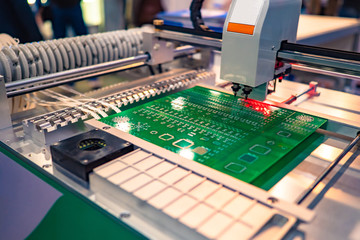
Surface Mount Technology or SMT is a method of manufacturing circuit boards. Otherwise, there would be through-hole circuit boards of different PCB designs. Most of the circuit boards you see in mobile phones today are a series of small chips placed on top of an electronic circuit board.
SURFACE MOUNT TECHNOLOGY
Surface mount technology does not require holes inside the circuit board. Instead, they are copper pads and copper traces on the circuit board. This surface mount technology is a semi-automated process that allows manufacturers to make all the different circuit boards for different products in-house.
With this technology, manufacturers can easily place electronic components on surface of PCBs. This mounting technique is very different from the insertion technique that manufacturers conventionally use with holes.
In other words, it is an alternative to the older practice of developing printed circuit boards using through-holes. As a new application, it overcomes many shortcomings of the through-hole technology on the surface mount.
SMD
One of the key features of surface mount technology is the SMD, also known as surface mount device. Browse the market and you’ll find a variety of SMD packages. These packages vary in different size and shape.
SMD PASSIVE COMPONENTS
The primary component of SMD resistors are capacitors or resistors. The package dimensions of these passive components have standard package dimensions. Other surface mount device components include crystals and coils.
In general, resistors and capacitors differ in shape, size, and dimensions. Other types of SMD components you can find are diodes and transistors. They are usually very small in size and shape. Leads are used to make connections inside the circuit board.
There are about three leads in these packages. Determining in which direction to slide the device will help to make a printed circuit board.
INTEGRATED CIRCUITS
You will find that there are many useful packages for integrated circuits. The implementation of the package entirely depends on the level of communication required by the component. For example, a logic chip with only 14-16 pins is installed. On the other hand, some processors and chips can be of 200 or more.
As requirements can vary, there are a variety of packages that you can look at. As with packaging, the processes involved in SMT manufacturing differ from the traditional hole-in-the-wall method of SMT PCBs.
SOLDER PASTE PRINTING
One of the processes in the SMT method is solder paste printing. This indicates the location where you need the parts. Printed circuit boards are usually very fine and covered with thin metal.
Printed circuit boards have contact pads for soldering. In surface mount techniques, stencils and squeegees are typically used to apply solder to relevant areas on a printed circuit board. This method of applying solder mask is widely used and has become popular. This is especially true for the subcontractor sector.
Conclusion
As you can see, Surface Mount technology is very important today and is prevailing against the traditional Through Hole methods. The specialty of surface mount technology in the PCB assembly manufacturing industry, along with its large-scale applications, has led to a rapid increase in the production of electrical equipment and technology. It propels the world towards a prosperous future.







